Plus some 1,500 student representatives from 95 countries
The 2015 Gyeongju Silk Road Culture Expo Student Festival was opened at the Expo Culture Center at the Expo Park in Gyeongju City some 231 miles southeast of Seoul on May 30, 2015 attended by over sixty ambassadors and other senior diplomats from 36 countries plus international media representatives and some 1,500 international student representatives from 95 countries of the world?as well as local government and civic leaders from Gyeongsangbuk-do Province and Gyeongju City (list of participants at the end of this Article).
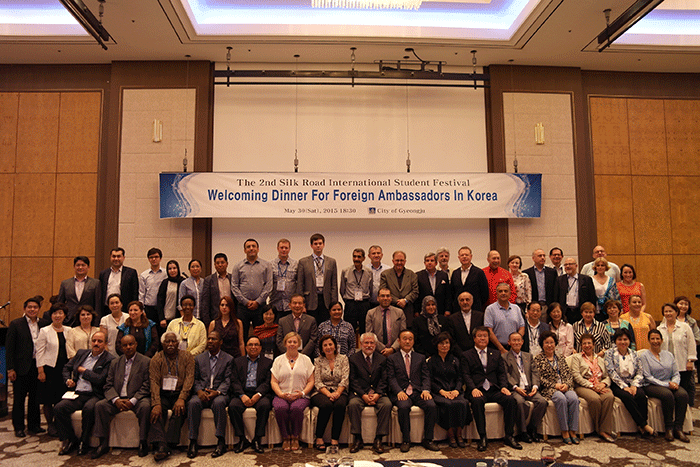
Attending the opening ceremony were Ambassador Herman Brantes of Chile and over 60 other ambassadors and spouses, Governor Kim Kwan-yong of the Gyeongsangbuk-do Province, Mayor Choi Yang-sik of the Gyeongju City, Chairman Park Kwon-hyung of the Culture-Environment Committee of the Gyeongsangbuk-do Provincial Council and other government and civic leaders of the central government as well as the provincial and city governments.
Welcoming the ambassadors and other senior members of the Seoul Diplomatic Corps, international student representatives and other guests, Governor Kim Kwan-yong said in part: “I am pleased to announce that President Park Geun-hye takes strong interest in the Gyeongju Silk Road Culture Expo, especially for our efforts put in, which she cited were a representative case good for the flourishing of the Korean and international cultures.

“In particular, on the occasion of President Park’s visit to Gyeongju in December 2013, the President extolled our efforts made for the 2013 Istanbul-Gyeongju Expo citing that Cultural Fusion was the Key Word of the 21st Century.” (Excerpts from the speech are toward the end of this Article.)
In response to the welcome speech of Governor Kim, Ambassador Herman Brantes of Chile spoke on behalf of the visiting members of the Diplomatic Corps. He said in part: “A long time ago, the Silk Road was a great journey of mankind that took place along the path of civilization, and today we have a new Silk Road, longest and wider, but of culture, economy, technology and cooperation that are transcending the differences between the countries, for which we congratulate the organizers of this Gyeongju Silk Road Culture Expo and particularly the government of Gyeongju for inviting us to participate in this excellent initiative.” (See excerpts from the speech toward the end of this Article.)
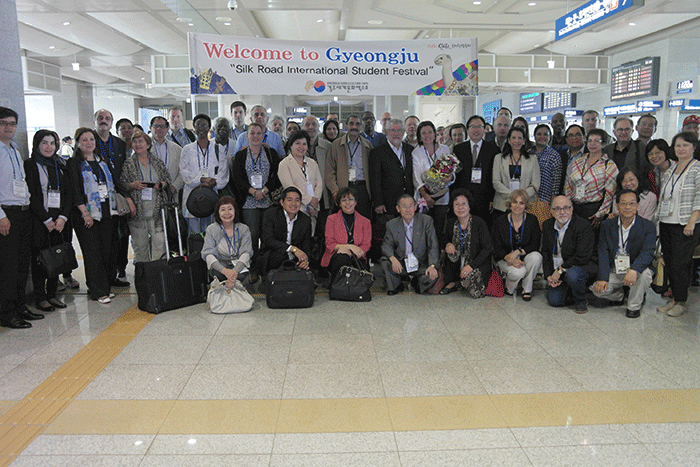
Then there was presentation of a Plaque of Appreciation by Ambassador Brantes to Governor Kim, in which Ambassador Brantes cited that the invitation greatly helped the ambassadors and other members of the Diplomatic Corps understand the Korean culture better and that it contributed greatly to the promotion of understanding, cooperation and friendship between Korea and the countries the ambassadors represented.
Then followed the congratulatory speeches by the chairman of the Provincial Council of Gyeongsangbuk-do and mayor of the Gyeongju City.
The opening ceremony was followed by Taekwondo self-defense art demonstrations and a fantastic show performance entitled Basilla, another name of the Korean Kingdom of Silla, which featured the romance and Royal Marriage of the Korean princess of Silla and the Iranian prince, which was based on the Persian Epic Poem of Kush Nameh.
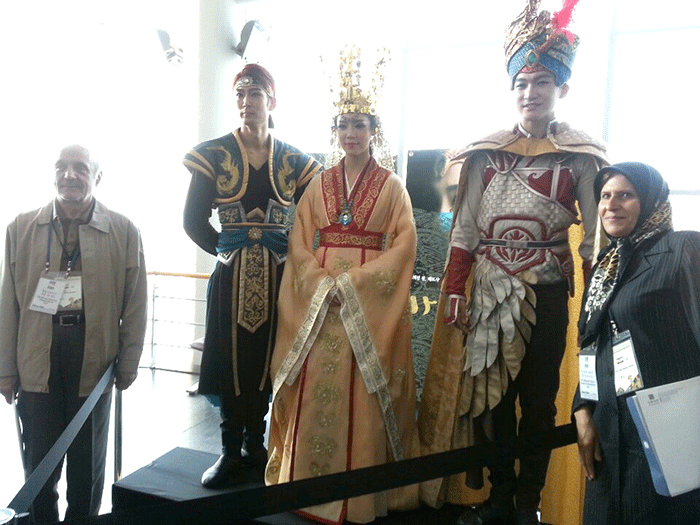
According to researches conducted jointly by Korean and Iranian scholars, Abtin, a Persian Sassanid prince, fell in love with, and was betrothed, to a Silla princess named Frarang at the invitation of a Silla King.
First escaping his home in the Sassanid Empire (A.D. 224 to 651) that collapsed under the waves of invading Muslim Arabs, Prince Abtin departed on a long and arduous journey that took him to the Silla Kingdom via China.
The Persian epic poem, Kush Nameh, then introduces the Royal Silla Dynasty marriage between Prince Abtin and Princess Frarang.
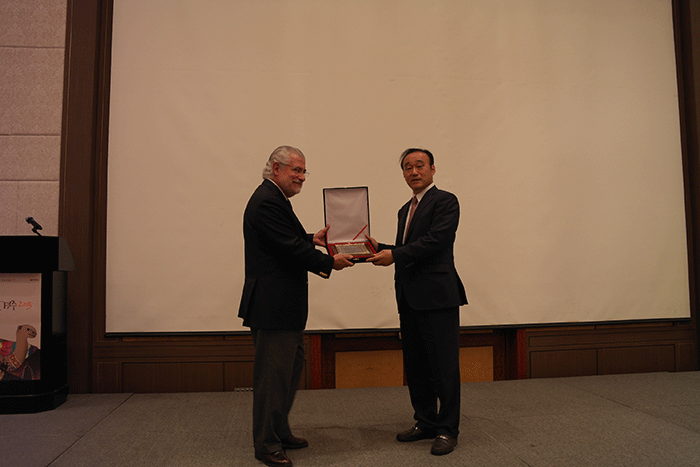
Prior to the opening ceremony, the ambassadors and other members of the Diplomatic Corps visited a room at the Expo Park where the national flags of 95 different countries of the world were shown on the walls each with a space for the ambassadors and visitors to sign their names and congratulatory remarks.
The ambassadors signed their names below their national flags and comments such as “Long Live the Korean-Ethiopian Friendship” written and signed by Ambassador Dibaba Abdetta of Ethiopia.
Following the opening ceremony, the ambassadors and other senior diplomats were invited to see an international fashion parade on an open-air stage presented by the student representatives of the different countries of the world where the modeling students, prominently co-eds, showed their brilliant and colorful traditional costumes to the loud applause of the viewers.
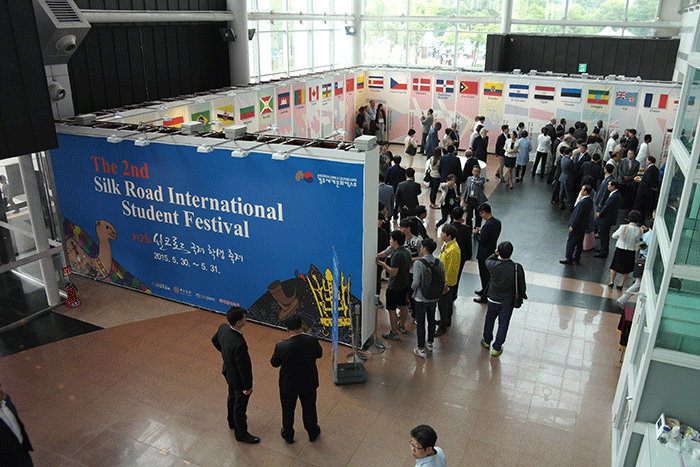
Then they were invited to visit dozens of national booths of the different countries where the student representatives showed their traditional handicraft items, costumes, foods and beverages. They all wore their national costumes attracting keen attention from the visitors for their distinctly different features such as shapes and colors from one another.
At some booths, the international students offered small prices of the tidbits of their countries for sampling. Many of the visitors said that they were so tasty.
It was pity that there was scattered rain that afternoon which substantially interfered with the diplomat guests’ fully enjoying the tour of all the international booths.
After the opening ceremony, the visiting ambassadors and the senior diplomats were invited to a dinner reception at the Gyeongju Hilton Hotel hosted by Mayor and Mrs. Choi Yang-sik and attended by the ambassadors and other visiting members of the Diplomatic Corps as well as the government and civic leaders of Gyeongju City and the Gyeongsangbuk-do Province.
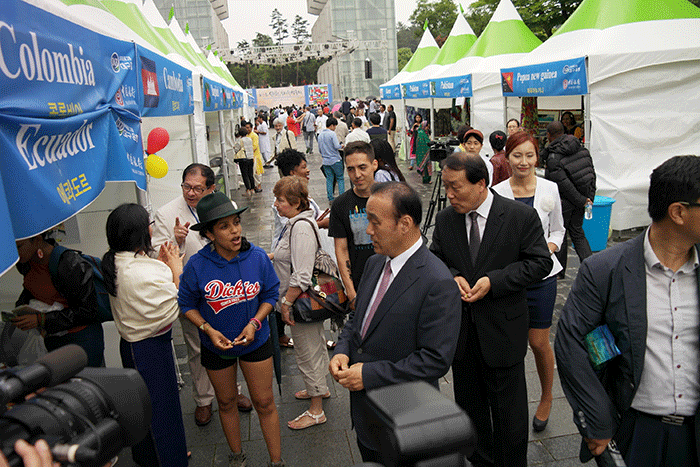
Welcoming the guests, Mayor Choi said: “At this time, I would like to share with the distinguished guests the good news that we are actively pushing ahead with a plan to restore the Palace of the Silla Kingdom together with its brilliant culture which, together with the opening of the Hwabaek Convention Center, will make Gyeongju a wonderful ‘international convention city,’ and more than fully meet the needs and requirements of the current national policy for flourishing the Korean and international cultures.” (See excerpts from the speech toward the end of this article.)
In response to Mayor Choi’s speech, Ambassador Herman Brantes of Chile made congratulatory remarks, where he said in part: “This occasion represents an excellent opportunity for increasing the mutual exchange and understanding among different peoples, cultures and realities.” (See excerpts from his speech toward the end of this Article.)
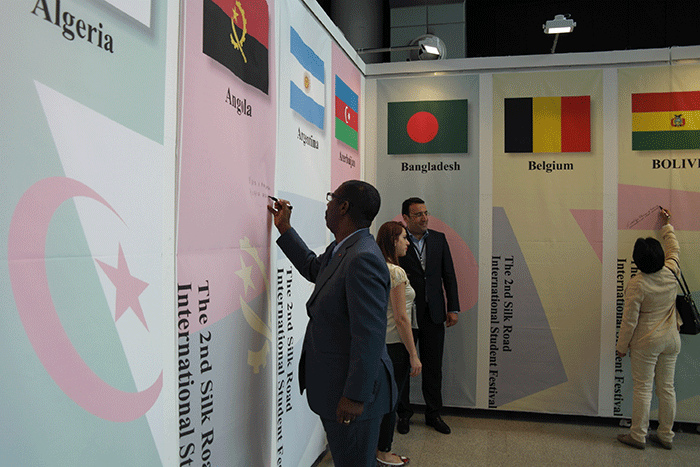
On the second day on May 31, the ambassadors and other senior diplomats, after an American breakfast at the Hilton Hotel, visited the famous Seokguram Grotto and the Bulguksa Buddhist Temple, and had a Buddhist luncheon that consisted of only vegetables and fruits completely devoid of any beef, pork or fish?not even a piece of tiny anchovy.
Naturally, to some guests who were accustomed to meat-fish diet, the Buddhist fare was somewhat bland without any meet-fish ingredients. However, it was complemented to some extent by Buddhist tea and tidbits prepared under a tent in front of the dining hall where Korean ladies in their mid-forties or in early fifties, all clad in traditional Korean Hanbok. They were seemingly from well-established families. They served tea and other traditional Korean beverages with traditional Korean Ddeok (small cakes) and Dasik (candies made with pine pollen and black sesame seed powder plus pinenuts, which are expensive for their rarity and which are considered to be especially good for health).
For the person of Chairman Lee Kyung-sik of The Korea Post, the day was among the happiest in his life as he was given a surprise birthday celebration by all the ambassadors and other senior diplomats. They presented a Happy Birthday song in English, Spanish, French and other languages led by the different ambassadors, especially Ambassador Mohamed Ali Nafti of Tunisia who sang it at least in two languages. The tasty birthday cake, prepared by the Gyeongju City authorities, was shared with the diplomat guests and somewhat supplemented the luncheon, the vegetarian fare, which had obviously fallen short of the palate and appetite of some guests who were more accustomed to meet-fish diet.
After the luncheon, the diplomat guests were invited to visit the Cheonmachong Royal Tomb of the Silla Dynasty. The tumulus was excavated in 1973 and was believed to date from the fifth century. The tomb was for an unknown king of the Silla Kingdom. It was a wood-lined chamber running east to west and was covered in a mound of boulders and earth. The tomb was 47 meters in diameter, 157 meters in circumference, and 12.7 meters in height.
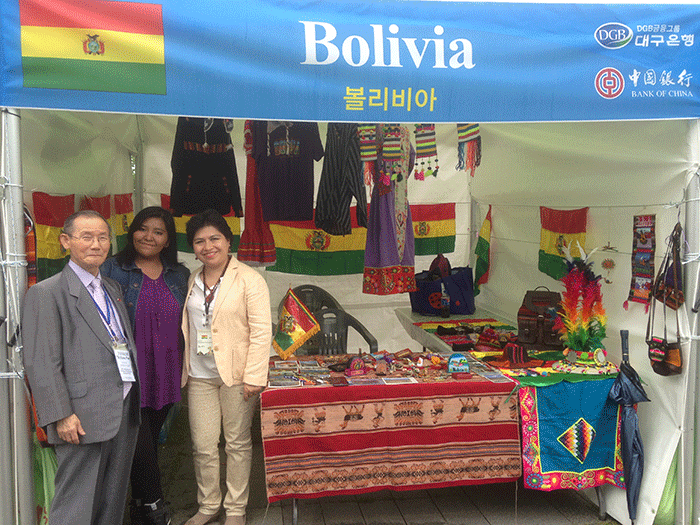
The chamber of the tomb contained a lacquered wooden coffin which had burial goods placed around it. A total of 11,500 artifacts were recovered from the tomb. The name of the tomb, Cheonmachong, translates literally, “Heavenly Horse Tomb.”
At the end of the tour, famed Korean Quilt Master Mrs. Kim Hae-ja, Important Intangible Cultural Asset Number 107 designated by the Central Government, presented each diplomat guest with a pair of silk scarves personally made by her with a wish that her works would be introduced to the world through the distinguished guests.
Also doing an excellent job was the Gyeongju City Police Station Chief Oh Byung-kook who sent three hard-working motorbike escort police officers (namely Ok Bong-chul, Lee Seung-hwan and Ha Yong-tak) and a number of plainclothesmen, who all did a wonderful job making sure that the ambassadors and other senior diplomats had a safe tour of the Gyeogju City throughout the one-night-two-day events of the 2015 Gyeongju Silk Road Expo Student Festival.
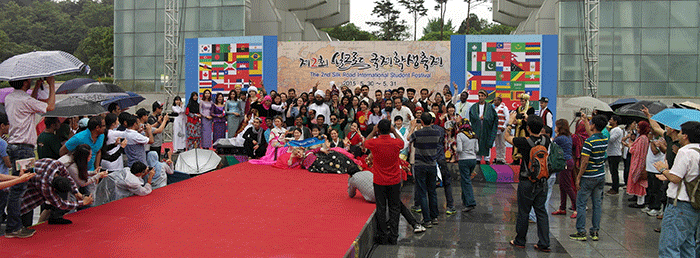
Excerpts from the welcome speech by Governor Kim Kwan-yong:
His Excellency Ambassador Herman Brantes of Chile, the Dean of the Visiting Members of the Seoul Diplomatic Corps, Honorable Mayor Choi Yang-sik of the Gyeongju City, Chairman Chang Dae-jin of the Gyeongsangbuk-do Provincial Council, Chairman of the Gyeongju City Council, representatives of the Seoul Foreign Correspondents Club of Seoul, distinguished guests, ladies and gentlemen, international student representatives,
I am immensely grateful for your kind attendance at the 2015 Gyeongju Silk Road Culture Expo Student Festival, which I hope will be the ‘Cultural Smelting Furnace of over 80 different countries of the world taking part in various interesting events taking place here, including fashion shows, cooking contests, dance performances and exhibition of artifacts in the different country booths of the world.
There will also be Taekwondo martial artist demonstrations and performances by cheer leaders, guitarists and Rock n’ Roll band troupes.
The Student Festival of the World Silk Road Culture Expo will be participated in by the representatives of the international student organizations in Korea and prove a true event where barriers of languages and cultures as well as national differences will be fully transcended.
The Gyeongju Silk Road Culture Expo will go far beyond the countries of Eurasia, and will embrace the entire world.
The ambassadors of 36 different countries of the world have so far kindly accepted our invitation to grace the Opening Ceremony of the Festival and I am especially grateful to the Excellencies taking time out of their busy schedule to be kindly present at this meeting.
I am pleased to announce that President Park Geun-hye takes strong interest in the Gyeongju Silk Road Culture Expo, especially for our efforts put in, citing that it was a representative case good for the flourishing of the Korean and international cultures.
In particular, on the occasion of President Park’s visit to Gyeongju in December 2013, she extolled our efforts made for the 2013 Istanbul-Gyeongju Expo citing that Cultural Fusion was the Key Word of the 21st century.
It is important to carry on the traditional culture and to continuously develop it. It is also important to accept the excellent aspects of foreign cultures and seek fusion between the Korean culture and foreign cultures.
The K-POP and Hallyu were born out of such fusion efforts of the Korean culture with the world cultures.
At her meeting with media representatives on Feb. 12, 2015 on her ‘New Year Plan,’ President Park stated that culture was the advance guards that explored and developed new economic territories in the world and a key content that continuously injected new energy into the Creative Economy.
The Gyeongsangbuk-do Province leads the Culture Expo together with the countries of the Silk Road and continuously develops it as a new cultural item.
In 2017, we will host the Silk Road Culture Expo in one of the Silk Road countries and seek new changes and try to make Gyeongju the center of the Silk Road culture.

Excerpts from the speech of Mayor Choi Yang-sik:
I extend my warmest welcome to the Excellencies and Madams and other senior members of the Seoul Diplomatic Corps as well as the 1,500 international students from a total of 95 different countries of the world. I am all the happier as we meet here in the balmy season of young lush green.

